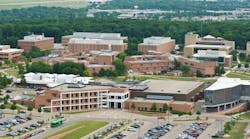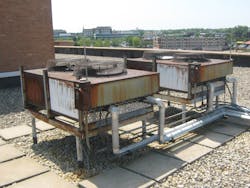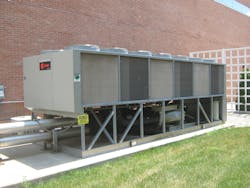In 2009, heating and cooling systems, lighting, and controls across the campus of Wright State University in Dayton, Ohio, were nearing the end of their useful life. With tax bases and resources dwindling in the tough economy of the time—Wright State had $28 million in deferred maintenance—a solution that did not rely on state funding or an increase in student fees was needed.
Wright State turned to facility-solutions provider ABM for help.
Solution
ABM suggested its Bundled Energy Solutions program, which allows universities to upgrade outdated and inefficient infrastructure with state-of-the-art, energy-efficient equipment and technology with a net-zero budget impact through guaranteed energy and operational savings.
ABM’s first step was to evaluate existing building systems to determine their remaining life and impact on student life. Next, a comprehensive engineering and financial model was developed. Several design strategies with numerous permutations, including LED lighting, advanced control programs, and distributed boiler plants, were evaluated.
ABM installed data loggers to capture run-time conditions of most of the major HVAC systems on campus. Trend logs were developed to track the performance of large HVAC systems. Utility-bill data, such as usage costs, kilowatt-hours used, kilowatt demand, and gas volume, were used to establish baselines for comparative analysis.
The program was significant in scale, spanning Wright State’s entire 557-acre campus. It was approved unanimously by the university’s board of trustees. Of special interest to the board of regents was the financial structure ABM and the university jointly developed, which took advantage of zero-interest air-quality bonds and a tax-exempt bond structure that produced an extremely advantageous interest rate.
Principal upgrades included the consolidation of boiler and chiller systems, which considerably reduced maintenance costs; the retrofit of exterior lights with LED and induction lighting, which cut lighting energy consumption nearly in half; and the installation of pressure-independent control valves, which dramatically reduced energy costs and HVAC-performance issues. In all, more than 230 energy-conservation measures were completed in 30 buildings.
Additionally, Wright State asked ABM to devise a solution providing affordable cooling to the Ervin J. Nutter Center, an entertainment and athletics venue, throughout the year. After exploring several options, ABM determined it could use a pond near the Nutter Center as a geothermal cooling system. With the addition of a heat exchanger equivalent to a 300-ton chiller in the pond, the center will have free cooling all winter or until outside-air temperature reaches about 80°F.
ABM guaranteed annual utility and operational savings of $1.3 million, which the university exceeded by more than 20 percent the first year.
Energy audits have shown savings every quarter since the Bundled Energy Solutions program was implemented. Wright State has experienced:
• A 21-percent reduction in energy consumption.
• Savings of 9 million kWh per year.
• Savings of 60,000 MMBtu per year.
As part of the project, the university received more than $250,000 in demand-side-management rebates from Dayton Power & Light. In 2012, as the project was drawing to a close, new leadership at Wright State decided to explore additional campuswide energy-efficiency projects, once again leveraging ABM’s expertise to design a fundable program that reduced its deferred-maintenance inventory.
Installation of “Phase 2” infrastructure began in February 2013 and is expected to be completed by the end of 2014. The audit period will begin in January 2015 and last 15 years, over which time ABM has guaranteed an energy-use reduction of 40 percent and savings of $35.8 million. First-year energy- and operational-cost savings are a guaranteed $2 million, or 40 percent. Electricity and natural-gas usage are expected to be reduced by 13,174,283 kWh and 92,142 MMBtu a year, respectively. This will result in a significant budget savings while reducing Wright State’s carbon footprint. Additional benefits for students, faculty, and staff will include:
• More-comfortable learning environments.
• Improved indoor-air quality.
• A significantly reduced deferred-maintenance inventory.
• A reduction in the number of assets requiring annual maintenance.
• Compliance with Ohio House Bill 251, which requires state organizations to reduce their energy consumption by 20 percent by 2014.
• No state oversight, new funding allocation, or program management was needed, as the program was designed, assembled, and delivered through the university’s staff and ABM.
For Design Solutions author guidelines, call Scott Arnold, executive editor, at 216-931-9980, or write to him at [email protected].











